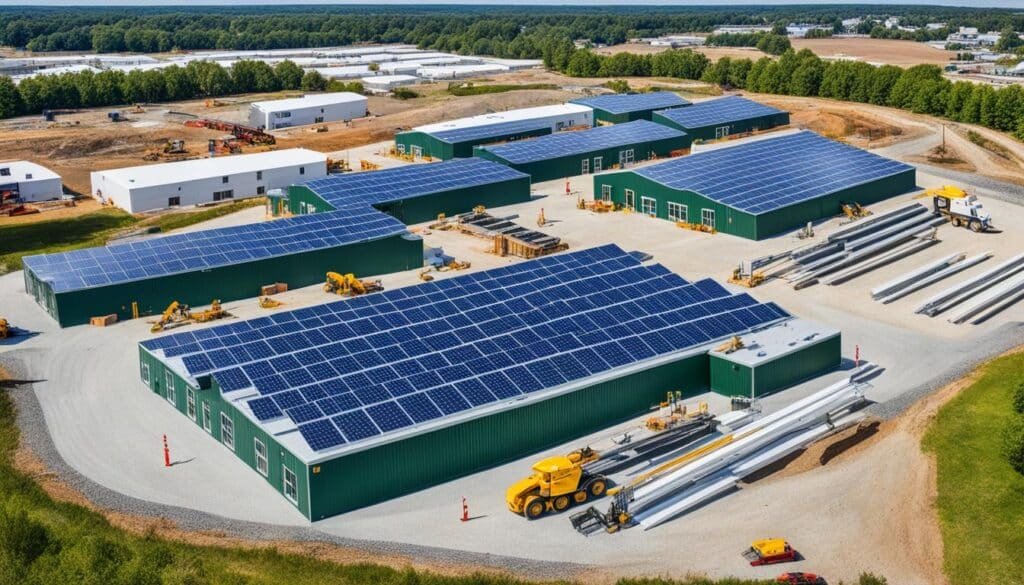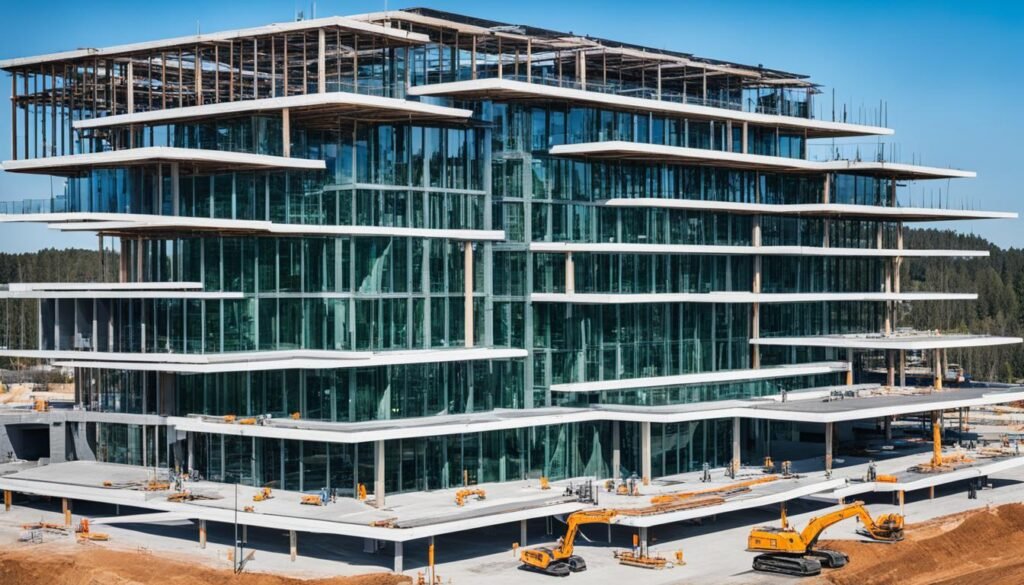The United States’ civil engineering sector is changing to tackle big global problems. These include climate change, quick urban growth, and the demand for greener infrastructure. It’s key trends encourage the use of new technology, eco-friendly building supplies, and tough design for infrastructure. These steps are aimed at making our environment more sustainable, efficient, and ready for whatever the future holds.
Key Takeaways
- Emerging technologies such as building information modeling (BIM) and 3D printing are being welcomed. They help improve how projects are managed and designed.
- Green construction materials like bioreceptive concrete are on the rise. This aims to make buildings and infrastructure less harmful to the planet.
- Using renewable energy and creating strong infrastructure are both important. They help limit the damage from climate change and severe weather.
- Modular construction and robotics are making building faster and better. They boost worksite efficiency and productivity.
- Geographic information systems (GIS) make smarter choices in where to build. They help with sustainable land use and planning.
Building Information Modeling (BIM)
Building information modeling (BIM) is a game-changer in civil engineering. It makes project work smoother and boosts teamwork. With BIM, design is more accurate, meeting all standards. Collaboration tools like SeveUp make communication better and help manage issues.
These new tools cut mistakes, help plan costs and schedules better, and check quality in projects.
BIM-Integrated Design Platforms
Today, BIM tools like D.TO are changing how civil engineers design projects. These platforms are powered by building information modeling. This means engineers can make more precise designs. They use BIM data to refine how projects flow, lessen design mistakes, and boost design accuracy.
Cloud-based BIM Collaboration Solutions
Good cloud-based BIM collaboration is key for teamwork among all involved in the project. Tools such as SeveUp’s platform make real-time talking and issue solving possible. This lets civil engineers, architects, and builders join hands more smoothly.
Such tools help a lot by making document sharing, solving problems, and checking progress easier all through the project.
“Building information modeling is not just a technology, but a way of working that enables more efficient and effective project delivery.”
Green Building Materials

Civil engineers lead the way in battling high energy use and harm to the environment. They do this by creating and using green building materials. These materials change the look of our world for the better. And they help build a circular economy in construction.
Bioreceptive Concrete Solutions
Startups like Respyre are making exciting bioreceptive concrete. This concrete soaks up carbon dioxide and helps cities be greener. It lowers construction’s carbon footprint. Plus, it makes buildings look cooler by encouraging moss and plants to grow on them.
Sustainable Concrete Alternatives
Nexii and other companies are creating sustainable concrete alternatives. These alternatives have much less embodied carbon emissions than regular concrete. They use things like self-healing concrete, recycled materials, and solar glass. This helps our planet. It also means we’re not using up as many natural resources. And we’re moving towards building in a way that doesn’t add any new carbon to the air.
“The future of construction lies in embracing green building materials that prioritize sustainability and environmental responsibility.”
The construction field is working hard to be less of a strain on our planet. Civil engineers, in particular, are making a big difference. They’re changing how things are built. They want our buildings and cities to be kinder to Earth.
Renewable Energy Integration

Civil engineers play a big part in making our future more sustainable. They’re using solar, wind, and kinetic energy to change how we power our world. This involves our buildings, bridges, and even how we move people and things.
Smart grids are one cool way to do this. They bring together energy from the sun and wind with the regular electrical grid. Using AI, these systems make sure clean energy is used well. This helps make our energy supply stronger and more earth-friendly.
There’s also work on using movement to create power. For example, when people walk or cars drive by, energy can be made and stored. This effort helps use less fossil fuels and makes a greener world possible.
Companies like Traverse Technologies are at the forefront of finding the best spots for wind farms. They use high-tech tools to decide where to put these important sources of renewable energy. This way, we can make the most power with the least harm to the planet.
More and more, the need for renewable energy is growing. Civil engineers are meeting this challenge. They’re coming up with new and smart ways to change our infrastructure. From smart grids to using movement for energy, they’re shaping a better future.
| Technology | Description | Key Benefits |
|---|---|---|
| Smart Grids | AI-powered platforms that optimize the distribution and storage of renewable energy sources like solar and wind. | Increased efficiency, reduced strain on traditional power sources, and enhanced energy resilience for communities. |
| Kinetic Energy Storage | Systems that capture and store the energy generated by movement, such as pedestrian traffic or vehicle motion. | Reduced reliance on fossil fuels, improved energy-efficiency, and more sustainable power sources for buildings and infrastructure. |
| Wind Energy Prospecting | Advanced algorithms and geospatial data used to identify the optimal locations for wind farms. | Maximized generation of clean, renewable energy while minimizing environmental impact. |
These new solutions are guiding us toward a future run by clean and smart energy. Civil engineers are key in the fight against climate change. With their work, our buildings and cities will be ready for a more sustainable future.
Resilient Infrastructure Design
Climate change’s effects are clearer, pushing civil engineers to focus on resilient infrastructure. This infrastructure can survive and change with the environment. It includes climate-resilient building codes to handle extreme weather risks. Also, features are added to help structures cope with disasters and climate changes over time. Civil engineers are making sure our built world can face future challenges. They protect communities, which lowers costs after huge disasters.
Climate-Resilient Building Codes
Implementing climate-resilient building codes is key in boosting resilient infrastructure design. These codes consider future climate challenges and the risk of worse natural disasters, like hurricanes and wildfires. They’re used in designing and building structures that can resist climate change adaptation. This enhances the chances of buildings and infrastructure lasting through the impacts of climate change adaptation.
Adapting to Extreme Weather Events
Civil engineers are looking into new ways to deal with extreme weather event mitigation. This could mean creating materials and designs that better handle strong winds and heavy rain. By getting ready for these issues, civil engineering experts protect towns and lessen climate change adaptation‘s long-lasting effects.
“Resilient infrastructure design is not just about withstanding natural disasters – it’s about creating a built environment that can adapt and thrive in the face of an uncertain future.”
Climate change underlines the big role of resilient infrastructure design. By tackling climate risks with strong building rules and new solutions, civil engineers are improving our communities’ readiness. They ensure our towns and cities cope well with future challenges.
Modular Construction

Modular construction is a new and smart way to build. It involves making building parts off-site. This method changes how we make our cities and homes.
There are many benefits to this way of building. It makes building quick and cheaper. Also, it’s good for the planet. It doesn’t disturb local areas as much. Plus, homes and cities can be built faster.
This method is great for controlling quality. Building parts off-site means they are made with care. This leads to less waste and a smaller impact on the environment.
Modular buildings are also easy to adjust for specific needs. This makes them perfect for building affordable homes or community projects. Being able to change them to fit different places is very useful.
“Modular construction is revolutionizing the way we build, offering a more efficient, sustainable, and customizable approach to urban development.”
With the need for more homes, modular construction looks very promising. It’s quick, eco-friendly, and flexible. This makes it a key player in solving our building needs in the future.
3D Printing and Robotics in Construction

The civil engineering world is changing fast with 3D printing and robotics. These new techs are making building faster, cheaper, and safer. They do this by taking over repetitive jobs and making it easy to create complex parts.
Automated Construction Processes
Thanks to 3D printing and robots, construction is getting a big upgrade. They let us make building parts with great accuracy and speed. This cuts down on human work and makes the job flow better. By letting robots handle tasks like moving materials, putting pieces together, and building tricky structures, we can cut mistakes and finish projects faster.
Design Flexibility with 3D Printing
3D printing isn’t just about making construction faster. It’s also a design wonder. Now, engineers can dream up unique buildings and complex parts without big issues on cost. With 3D printing, the impossible is becoming reality. Engineers get to be creative, make structures stronger, and produce projects that stand out.
The mix of 3D printing and robots is changing civil engineering. It’s making construction smarter, cheaper, and safer. This shift is also unlocking new levels of design creativity and making big dreams in building come true. The future looks bright as these new ways take over.
| Benefit | Description |
|---|---|
| Automated Construction Processes | Streamline workflows, minimize errors, and boost project completion speed through the automation of tasks such as material handling, assembly, and complex structure construction. |
| Design Flexibility | Explore innovative architectural forms and deliver more versatile and visually stunning infrastructure projects by leveraging the capabilities of 3D printing. |
| Increased Efficiency | Enhance productivity, reduce labor costs, and improve workplace safety through the integration of 3D printing and robotics in construction. |
“The integration of 3D printing and robotics is revolutionizing construction processes in civil engineering, driving increased efficiency, cost savings, and improved safety.”
Advanced Materials for Civil Engineering

In civil engineering, advanced construction materials are key. They change how we make buildings and roads. These materials are light, strong, and good for the environment. They include things like carbon fiber and self-healing concrete.
Recycling and using things from nature are big steps forward. Civil engineers use old wood, bio-insulation, and more. This keeps the planet healthy and helps materials last longer.
“The incorporation of advanced materials in civil engineering projects has the power to drastically enhance the performance, sustainability, and resilience of our built environment.”
Civil engineers are also looking at new tech. Things like self-healing concrete and special metals could make structures last longer. These advanced construction materials might change how we build things in the future.
The need for sustainable building is growing. The civil engineering field is ready for big changes. With these new advanced materials, our future builds can be better for the earth.
Geographic Information Systems (GIS)
Geographic information systems (GIS) are changing civil engineering. They help make better project decisions and improve how infrastructure is built. By using GIS, civil engineers study data to pick the best project locations.
GIS for Site Selection and Land-Use Planning
Companies like Continuum Industries lead the way in using GIS. They look at many factors, like the land, the environment, and transportation. This detailed analysis lets civil engineers choose the best spots for projects. They can make plans that use space wisely, help the environment, and meet local needs.
GIS is great for finding the right spots for projects. It helps civil engineers in several ways:
- They can find the best locations for projects, considering things such as how easy they are to get to, what resources are available, and environmental limits.
- They can plan where to put buildings, roads, and more to cause less trouble and work better.
- They can include green ideas, like protecting natural areas and reducing the project’s carbon footprint, in their designs.
By using geographic information systems, civil engineers make sure their projects are well-placed. This helps the community, protects the environment, and works well for a long time.
“GIS technology is changing how civil engineers think about choosing sites and planning projects. It supports smarter, more sustainable building.”
Civil Engineering and Climate Change
The construction industry, which includes civil engineering, is key in fighting and reducing the effects of climate change. Civil engineers lead the charge by using sustainable designs, engineering, and building practices. These help lower the environmental impact of big projects.
Creating infrastructure that can survive extreme weather due to climate change is critical. Civil engineers work on buildings, roads, and bridges that will stand up to more storms and heat waves. They do this by adding renewable energy, using eco-friendly materials, and adopting new building methods that help structures change with the weather.
Reducing the carbon footprint of civil engineering is vital as well. They do this by choosing environmentally friendly options like sustainable concrete and using materials that help nature grow on them. Adding renewable energy to their projects is another step. These steps make important contributions to a greener, more sustainable world.
With climate change becoming more severe, civil engineers are on the front lines. They create and build structures that can cope with future weather changes. By following sustainable practices, they are making sure our living spaces are ready for the future. This effort makes life better and safer for everyone across the U.S.
| Sustainable Civil Engineering Practices | Benefit |
|---|---|
| Climate-resilient infrastructure design | Enhances a structure’s ability to withstand extreme weather events |
| Use of sustainable concrete alternatives | Reduces the environmental impact of construction materials |
| Integration of renewable energy sources | Decreases the carbon footprint of infrastructure projects |
“The civil engineering profession has a fundamental role to play in addressing the challenges posed by climate change. By embracing sustainable practices and designing for resilience, we can create a built environment that is better prepared to withstand the impacts of a changing climate.”
Structural Monitoring and Assessment
Keeping civil infrastructure safe and working well is crucial for engineers. They use advanced tools like smart sensors to check on structures all the time. This lets them know early if something might go wrong. With these tools, maintenance can be done at the best times. They also help by making sure structures are as safe as possible for everyone around.
Smart Sensors for Infrastructure Monitoring
Smart sensors are changing how we take care of our buildings and bridges. They gather information about things like if a structure is moving too much or gets too wet. This real-time information can show if there’s a safety risk. Then, engineers can fix it before it gets worse.
- Sensors look at things like how much a structure shakes, the temperature, and if it’s too wet, to spot damage early.
- Using sensor data, engineers can guess when something needs maintenance and plan repairs better. This saves time and money by avoiding sudden fixes.
- By using high-tech tools like machine learning on sensor data, they can pick up on trends. This helps set up care plans that make structures last longer.
More and more, the engineering field is turning to smart sensors for its work. It’s all about making smart choices based on evidence. This keeps our important structures up to snuff for future generations.
Also Read: What Are The Key Responsibilities Of Civil Engineers In The US?
“The integration of smart sensors into civil infrastructure is revolutionizing the way we monitor and maintain our built environment.”
Conclusion
In the USA, civil engineering is changing fast. It’s because we have to tackle big global issues. These include making our world more sustainable, efficient, and ready for the future. Building information modeling (BIM) and using green materials are part of this change. So is finding new ways to make energy and building to resist effects of the changing climate.
Civil engineers are leading this change. They use new tech, better materials, and designs that are kind to the earth. All of this effort aims to make our places stronger and ready for what’s next. The future of civil engineering in the USA is all about civil engineering trends, sustainable construction, and resilient infrastructure. It’s also about making the most of technology in construction.
The future of civil engineering is exciting. It’s all about making our world a better, safer place. This means our buildings and cities are ready to face changes, like those from climate change. Through new ideas and teamwork, civil engineers are making a big positive difference.
FAQs
What are the latest trends in sustainable civil engineering in the USA?
The civil engineering field in the USA is evolving. It is tackling big global issues like climate change and urban growth. Some major trends include using new methods for project management, adding green materials and renewable energy, and designing infrastructure to be strong in bad weather.
There is also more use of modular building and advanced tech like 3D printing and robotics.
How is building information modeling (BIM) transforming the civil engineering industry?
Building information modeling (BIM) is changing how civil engineering works. It makes projects flow better and lets everyone work together easily. BIM tools help spot design mistakes early, improve cost predictions, and make sure projects are top-quality.
What innovative green building materials are civil engineers using?
Civil engineers are looking into materials that save energy and are kinder to the planet. They’re using special concrete that captures carbon and helps city plants grow. Other companies offer green concrete that’s much better for the Earth than the usual kind.
Self-healing concrete, old construction materials used again, and glass that makes energy are also changing how we build. This makes building stuff use less of the Earth’s natural materials and is kinder to the planet.
How are civil engineers integrating renewable energy solutions?
To use up less of the Earth’s resources and make things more reliable, civil engineers are adding more renewable energy. There are new tech tools that help find the best spots for wind farms. And, companies are coming up with ways to make the most out of renewable energy sources.
They’re adding more solar and wind power to smart grids and using ways to store energy in the buildings themselves. This cuts down on how much traditional power grids are needed and makes our energy use more sustainable.
What strategies are civil engineers using to design resilient infrastructure?
As the world changes because of the planet’s climate, civil engineers are focusing on infrastructure that can last. They’re making buildings and roads that can take bad weather and other tough conditions.
They are also adding things to these structures that help them survive disasters and climate changes over time.
How is modular construction transforming the civil engineering industry?
Modular construction is becoming a key part of civil engineering. It means building large parts of a project somewhere else, then bringing them together. This way of building has many benefits like less waste, more control over quality, and it’s great for building homes and cities sustainably.
What is the impact of 3D printing and robotics in civil engineering?
3D printing and robots are changing how we build things in civil engineering. They make building faster, cheaper, and safer by doing hard jobs for us. 3D printing lets us make things in amazing new shapes and ways. Before, these were too hard or cost too much.
What advanced materials are transforming the civil engineering industry?
Civil engineers are always looking for new materials that make our buildings and roads last longer and be more sustainable. They’re using things like strong carbon fibers and concrete that heals itself.
Recycled and natural materials, like old wood and special insulation, are also a big part of this. This relaxes the strain on our planet’s resources and get us to use them over and over in building.
How are geographic information systems (GIS) contributing to civil engineering?
GIS is very important in civil engineering. It helps us make smarter choices when picking where to build things. GIS tech looks at the land, the environment, and how to get there, giving engineers the best data for their projects.
What is the role of civil engineering in addressing climate change?
Civil engineering has a big role in dealing with climate change. They’re finding ways to design, build, and use our buildings and structures that are kind to the Earth. More efficient materials, renewable energy, and structures that can take extreme weather help a lot.
These steps make our construction work use less of the Earth’s resources and make our spaces safe even as the climate changes.
How are advancements in structural monitoring and assessment technologies improving civil infrastructure?
Keeping our buildings and roads safe over time is very important to civil engineers. They’re using smart monitors to check on them all the time. This way, they can fix small problems before they become big ones.
With this tech, engineers can plan when to do maintenance, know when something needs to be fixed, all to keep our buildings and roads safe and strong.
Source Links
- https://www.startus-insights.com/innovators-guide/civil-engineering-industry-trends/
- https://www.linkedin.com/pulse/top-emerging-civil-engineering-trends-shaping-future-our-aneesh-goly
- https://www.ey.com/en_us/insights/real-estate-hospitality-construction/how-sustainability-reshapes-engineering-and-construction

